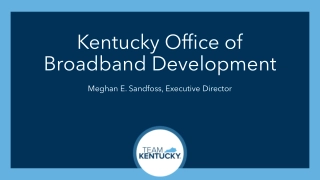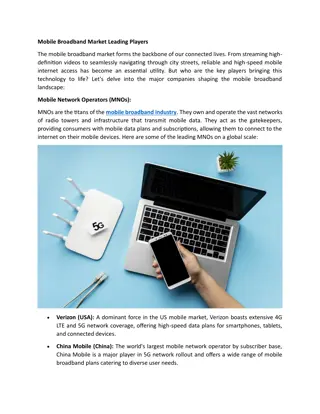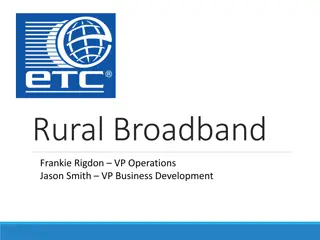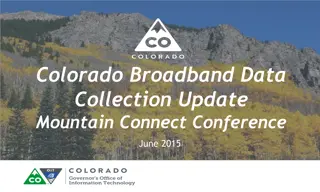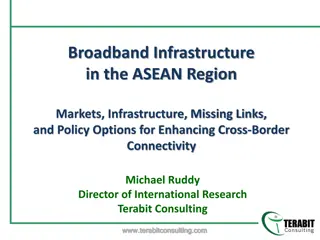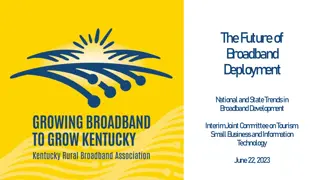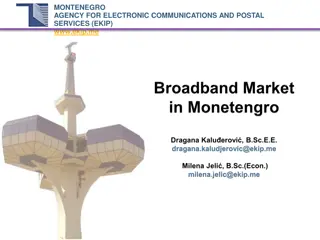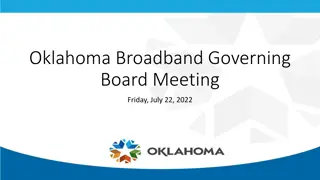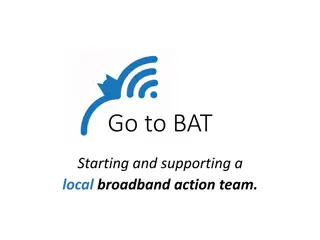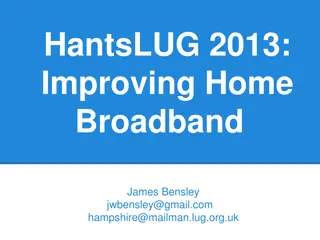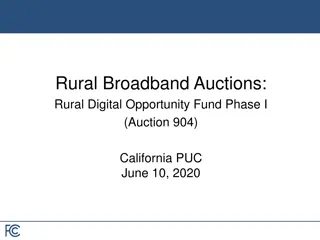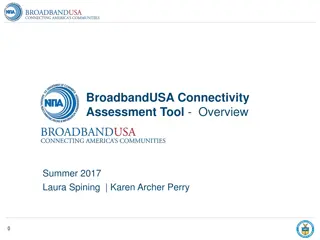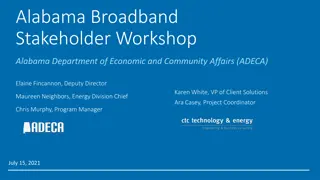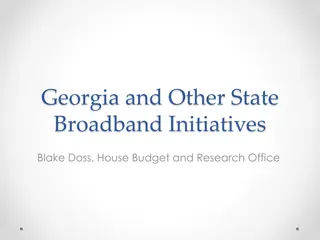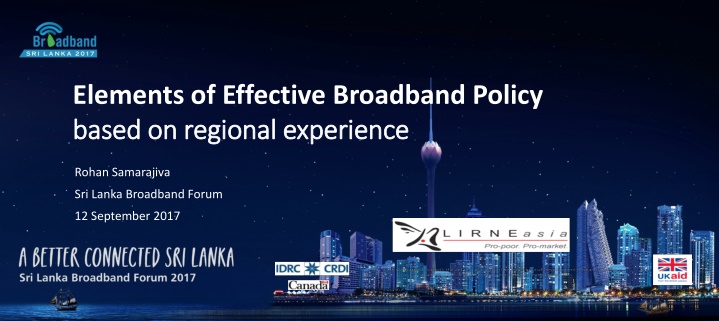
Effective Broadband Policy Insights from Regional Experience for Sri Lanka and Peers
Gain insights into effective broadband policy elements based on regional experiences, including a comparison with Sri Lanka's regional peers. Explore key indicators such as mobile subscriptions, internet users, and more to assess performance. Learn from government broadband initiatives in the region and understand the internet ecosystem infrastructure strategies in countries like India, Malaysia, Australia, and Indonesia.
Download Presentation

Please find below an Image/Link to download the presentation.
The content on the website is provided AS IS for your information and personal use only. It may not be sold, licensed, or shared on other websites without obtaining consent from the author. If you encounter any issues during the download, it is possible that the publisher has removed the file from their server.
You are allowed to download the files provided on this website for personal or commercial use, subject to the condition that they are used lawfully. All files are the property of their respective owners.
The content on the website is provided AS IS for your information and personal use only. It may not be sold, licensed, or shared on other websites without obtaining consent from the author.
E N D
Presentation Transcript
Elements of Effective Broadband Policy based on regional experience based on regional experience Rohan Samarajiva Sri Lanka Broadband Forum 12 September 2017
How are we doing, compared to regional peers? Mobile Subscriptions/100 Internet Users/100 Facebook Users/100 Country 2016 2016 2017 71.4 15.5 15.8 Pakistan 77.9 18.3 15.8 Bangladesh 87.0 29.6 15.9 India 89.3 25.1 29.2 Myanmar 109.2 55.5 59.7 Philippines 118.5 32.1 25.0 Sri Lanka 149.1 25.4 44.4 Indonesia 172.7 47.5 70.3 Thailand Sources: http://www.itu.int/net4/itu-d/icteye/AdvancedDataSearch.aspx; http://datatopics.worldbank.org/hnp/popestimates; facebook advertising portal; 2
On composite indicators . . . Sri Lanka Bangladesh Cambodia Myanmar Thailand Network Readiness Index (2016) - out of a possible 139 112 109 133 62 63 ICT Development Index (2016) - out of a possible 175 145 125 140 82 116 Inclusive Internet rankings (2017) - out of a possible 75 46 55 54 23 41 Human Development Index (2016)- out of a possible 188 139 143 145 87 73 3
Gunaratne, R.L. et al. (2015). National broadband networks of Malaysia, India, Indonesia and Australia: A comparative study. Competition and regulation in network industries. Vol 16(1): 23-46. What can we learn from government broadband initiatives in the region?
Internet Ecosystem Infrastructure NBN Australia wholesale Palapa Ring connecting all HSBB FTTH in industrial areas BBGP connectivity via multiple network FTTH, fixed wireless or Islands through fiber NOFN fiber from block to gram panchayat level tech in rural areas Satellite Attractive Content/ Applications Affordable User- friendly Devices India Malaysia Australia Indonesia 1Malaysia Netbook Distribution Introduction of e-gov, e-education and e- health App Development Centre portal E-gov, e-health, e-education, e-commerce My1Content Skilled Users Government User Network Anchor client Digital Literacy Program Tax breaks Broadband Carnivals, ICT Training Affordable packages literacy Programs to improve ICT 5
Malaysia High Speed Broadband Network (HSBB) as at April 2014 25 Operators for HSBB Transmission 1.74Tbps total International Bandwidth Capacity (from 682Gbps) 5 Operators for HSBB Access 1.5 million Ports installed TM Fiber Network International Connectivity Customers 723,014 Subscribers (48% take up) International Backhaul Access Network Domestic Backhaul Implemented by Telekom Malaysia, as a PPP with Gov. Total cost 3.5B USD, out of which Gov spent 0.75B. Conditions of access to network are commercially negotiated Broadband for General Population subsidizes BB in rural areas using Universal Service Provision Fund
Where does the money come from? Country Source of funds India 5% of adjusted gross revenue Malaysia 6% of weighted gross revenue, levied on operators with revenues from designated services above RN 2 million Nepal 2% of annual income Pakistan 1.5% of adjusted revenue Sri Lanka USD 0.03 per minute on international calls terminated in the country
Malaysia: Lots of money, but not spent 12000 100.00 90.00 10000 80.00 70.00 8000 USD million 60.00 6000 50.00 % 40.00 4000 30.00 20.00 2000 10.00 0 0.00 2003 2004 2005 2006 2007 Disbursements Y-o-Y disbursement rate 2008 2009 2010 2011 2012 Accumulated funds 2013 2014 Inflows Accumulated disbursement rate Source: Universal Service Provision Fund of Malaysia (2015) Annual report 2014. Calculations, graphics by authors
Sri Lankas universal service fund is smaller, but much remains unspent
Think in terms of entire eco system like Malaysia Action required on all fronts, not just infrastructure But this does not mean government should try to do everything What are required are partnerships & creation of conditions for others to innovate & invest
Investment, not subsidies Taxing incoming and outgoing calls in this day and age is silly Sri Lanka has desisted from imposing universal-service levies; now is not the time to start Spend down the accumulated funds and rely on PPPs for continuation Is subsidies are needed Use general tax revenues Go for matching funds, not pure subsidies Investment has to be priority
Investment comes when there is certainty and predictability Understand that what amount to overlay networks will have to be built; major investments are required Also understand that creating platforms for applications will require investment For major investments, with relatively long gestation periods Uncertainty in tax environment must be reduced Regulatory risk must be reduced, especially re market entry-exit, scope of licenses & spectrum
Increasing taxes can decrease revenues . . . Pakistan case GST rates on telecom charges In 2008, PTA conducted a tax-impact analysis, concluding that "with the given increase of tax rate from 15% to 21% the GST collections will decline" Loss to governmental revenue in the first quarter of fiscal year 2008-9 was a predicted As a result, GST rate was reduced from from 21% to 19.5% in next budget; revenues increased
. . . and also depress demand It does not make sense to tax a service that is being encouraged Recent reduction of excessive sector-specific tax on data is a good start
Reduce regulatory risk . . . Market exit Who can best decide number of suppliers? Not Minister; not regulator; but the market Transparently assign as many licenses as resources (spectrum) permit in blocks adequate for purpose (minimum of 5MHz for 3G, 10Mhz for 4G); no point in fragmenting increasing costs Allow secondary trading so operators can find the optimum distribution of spectrum Create orderly exit mechanisms (ideally, known at time of entry), so that market can settle at optimum level Includes rules on spectrum, secondary trading is a solution Also safeguards for consumers
Reduce regulatory risk . . . Spectrum Spectrum is the most critical input in providing wireless broadband access Spectrum refarming is central All users of spectrum must understand that assignments are not for ever; that countries that are technology-takers must realign their spectrum assignments periodically Difficult process; I did it in 2002-04 (900 and 1800 bands) Requires extensive consultation with all affected stakeholders Lots of listening and talk Need to use proceeds of auctions to compensate losers Digital transition for 700 MHz Band must be highest priority Operators must be able to plan and to mobilize resources Not just a question of auctions versus administrative allocation Auctions are best, but unless embedded within a credible roadmap, they will distort bidder s incentives
Reduce regulatory risk . . . Road map Best way to improve spectrum regulation is to set out principles and a schedule for refarming actions (known as roadmap) Make principles explicit and include time (when specific blocks will be refarmed/made available) To the extent possible, reduce technology bias in spectrum assignments: e.g., why should 900 band be limited to specific technology? Change and certainty All should recognize that nothing is permanent in spectrum assignments But change should be predictable and the path decided through extensive consultation based on principles
Government needs revenue. Policy choice: Now or over time? Take as much as possible upfront OR create conditions for continuing revenue streams? Sri Lanka has held a few auctions, but fees have been relatively low (e.g., 5th mobile license to Airtel went for USD 4 m); but TRC is the biggest contributor to Treasury: USD 98.2 million expected in 2017 (in addition to USD 5.2 million from SLT as dividends) Auctions are the best way to allocate scarce resources They can be designed to encourage rapid rollout OR optimize revenue
Sri Lanka needs new ICT legislation to create a modern regulatory environment Sri Lanka needs new ICT legislation to create a modern regulatory environment Working under a 26-year old law Act governing the sector is from 1991; amended in 1996 Abuses of Fund which saw criminal misappropriation of USD 4 million is just one symptom Time to develop a new statutory framework and restore legitimacy of regulator

